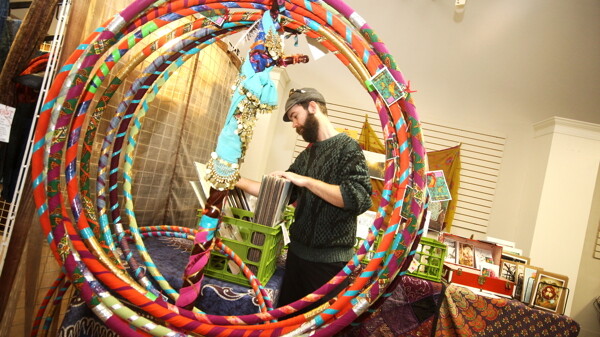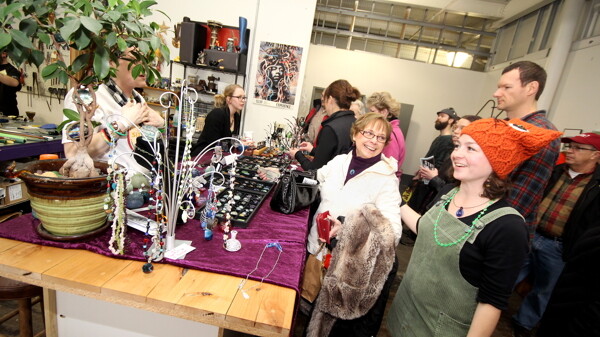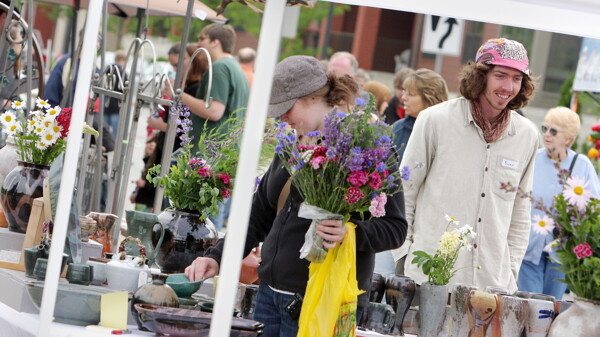Does it Pay to Sell?
How to sustain your community art event: get creative, work hard, and find people who will actually buy art.
Tom Giffey, photos by Andrea Paulseth |

While it’s not as difficult as judging art itself, judging the success of an art event is a complicated endeavor. Should the number of artists whose work is on display be the barometer of success? The number of visitors? The objective (or subjective) quality of the works on display? Or – not to put too fine a point on it – if the artists involved were able to convert enough of their creativity into cash to make it worthwhile?
If you ask artists and organizers, you’ll get a combination of these and other answers – as well as differing assessments about whether local art events are sustainable.
By most measures, last month’s fourth annual Banbury Art Crawl was successful. It attracted an estimated 3,000 visitors who wandered their way through the hallways of Building 13 at Banbury Place, where they saw 65 exhibitors, including 30 artists and craftspeople who have their studios in the former tire plant.
“I think it’s about a community,” Jo Burke, chairwoman of the Banbury Art Crawl’s organizing committee, explained when asked about the purpose of the crawl. “Being able to be around other artists as well. To be around that sense of creativity that’s so often lacking in our daily lives.”
Fostering creativity and community – as well as exploiting the mystique of the funky old factory – were among the motivations for creating the Art Crawl in the first place, says Laurie Bieze, who co-founded the event with Adam Fuller. But there were more straightforward reasons as well.
“The point for the artists is to make money,” says Bieze, an Eau Claire stained-glass artist and sculptor. “That’s how they pay their rent. This year, I think a number of people had a good year and a number of people had a bad year.”

but not everyone was a buyer.
Are Sales Secondary?
The intersection of art and commerce inevitably creates contradictions. Artistic experiences may be priceless, but if no one ever paid for art, it might well vanish.
But are the Art Crawl and other art events solely money-making ventures for artists? Are they catalysts for future sales? Or do they exist mainly to expose the public to art?
“If people come to just have a good time and walk around and look at art, that’s great. That’s what art’s about,” said Barbara Shafer, a painter with a studio at Banbury Place who is on the Art Crawl’s organizing committee. If artists sell some of their work – and Shafer and her husband, fellow painter Anders Shafer, were pleasantly surprised by their sales at this year’s Art Crawl – she sees that as a bonus.
Burke agreed that merely making sales shouldn’t be the goal.
“If you come here to be a big entrepreneur and make a lot of money, you’ve come to the wrong place,” she explained.
For her part, Chetek-based painter and Art Crawl committee member Patricia Mayhew Hamm said artists should focus on the longer term with such art events.
“Some of us can be a little temperamental,” she said of her fellow artists. “If they don’t make a lot of sales, they don’t come back.” However, she said, that’s the wrong attitude to have: “Exposure is great. If you’ve been there year after year, people come hunting for you. ... They might remember you. They might remember a painting too.”
But Will They Buy?
However, over the long term, art festivals aren’t sustainable if the public isn’t buying. And the works of many fine artists, from painters to potters, carry price tags that are beyond impulse-purchase territory for most Chippewa Valley residents.
“I think people want $30 to $50 things,” said Burke, the Art Crawl chairwoman. “They don’t want to pay more than that.”
“There’s definitely people who want to buy art here, but people say, ‘$100? My God, that’s so expensive.’
I understand, but I’ve been to other parts of the country where people say, ‘$500? That’s cheap.’”
– Jason Anhorn, artist and organizer of the
Open Air Festival of the Arts
Jason Anhorn, an Eau Claire artist and organizer of the annual Open Air Festival of the Arts, which is held in Phoenix Park each June, agrees that the art-buying public in the Chippewa Valley is frugal.
“There’s definitely people who want to buy art here,” he said, “but people say, ‘$100? My God, that’s so expensive.’ I understand, but I’ve been to other parts of the country where people say, ‘$500? That’s cheap.’ ”
Anhorn said that while beginning artists at his fair may be merely trying to build their audiences, the majority of exhibitors make their living from their art.
“Everybody would love to sell all their work and leave with their pockets full,” he said.
Achieving that goal can be difficult, however. “Everyone seems to make something. Not a lot,” Anhorn said of exhibitors. “They make some profit, but it hasn’t been a great festival for selling high-end work especially.”
Erin Roesler, co-founder of the Artist Market of Eau Claire, which debuted last summer at Phoenix Park, acknowledged that Eau Claire can be a hard place to sell fine art. However, she said she received only positive feedback from those who exhibited at last year’s series of nine Saturday markets. Some people, such as fine artists whose work was more expensive, were able to establish leads for commissioned works; others, such as small-scale soapmakers, were thrilled to make their first-ever sales.

studios are in the converted tire factory as well as outside exhibitors.
Making the Circuit
Attitudes toward art fairs seem to differ based on an artist’s objectives. For example, Carmen Iannarelli, a first-time Art Crawl exhibitor who makes handcrafted jewelry, set multiple goals for the recent event – selling a certain dollar amount, boosting exposure (she’s since seen an uptick in website traffic), and networking with other artists – and exceeded all of them. While many visitors seemed content just to look, Iannarelli noted there were many buyers in the crowd as well and added that she saw some visitors taking part in the crawl on both days it was held.
Iannarelli wishes she would have had the opportunity to explore the crawl as a visitor, not just as an artist: “It was amazing to see as many beautiful pieces in such an amazing variety of mediums,” she said. “It reminds you how vibrant the art scene really is, right here in the Chippewa Valley.”
Allan Servoss, a painter from New Auburn, agrees that there are talented artists at work around Eau Claire. However, he’s skeptical of the quality of the art fairs in the region, as well as the buying public’s willingness to pay for art. While he exhibited at the very first Banbury Art Crawl, he doesn’t do so anymore. Now he’s happy to leave his art at home and play his guitar at the event in exchange for tips, which he donates to charity.
“If people come to just have a good time and walk around and look at art, that’s great. That’s what art’s about.” – Barbara Shafer, artist and Banbury Art Crawl committee member
“For years and years I did the art fair circuit,” says Servoss, who has been a professional artist since the 1970s. “I did shows all over. I never liked it, even when I was younger. ... It was a right of passage in a way.”
At best, art fairs are a hassle, requiring artists to travel, then set up and take down displays; at worst, they are a costly waste of time if an artist don’t sell anything.
While he now sells his work through galleries, early in his career Servoss would exhibit at both juried and non-juried art fairs. Fairs in cities such as Madison, Minneapolis, and Chicago drew well-established artists and serious buyers.
“They were trying to make the quality of the shows very, very high,” Servoss recalls. At one fair in Chicago, for example, another painter was selling works for $7,000 to $8,000.
However, Servoss notes that the Great Recession hit the art world as hard as it hit other parts of the economy. Art galleries have gone out of business, and Servoss suspects art fairs aren’t as lucrative as they once were. This, he believes, has led to a decline in the quality of art on display.
“There’s work being accepted to these shows now that never would have been accepted 15 or 20 years ago,” he says.
And when the quality of the art offered for sale declines, potential patrons are likely to limit what they spend, agrees Bieze, the Art Crawl founder.
If it’s all good art, it helps the artists a lot,” she says. “If there’s some really good art and it’s worth $500, and it’s next to a group that sells booties and gloves for 5 or 10 bucks, the people usually end up buying booties and gloves.”
Keeping it Going
Art Crawl organizers are upbeat about the sustainability of their event, which is now overseen by a committee of about 10 people. But they acknowledge that art events have come and gone in the community because organizing them is time-consuming and not terribly lucrative.
Bieze recalls an art fair once held in Owen Park in conjunction with the Harvest Festival. At one such fair in the late 1980s or early 1990s, Bieze remembers seeing artists pack up their works hours early because no one was buying. The fair only lasted only a few years, she noted.
Nonetheless, she’s optimistic about the survival of the Banbury Art Crawl.
“I think that it can be sustainable,” she says. “I think it’s something that people are starting to look forward to.”
Anhorn, who supports himself as a visual artist, said he loves putting on the Open Air Festival of the Arts, which will be in its seventh year this summer. But he admits it’s hard work – he’s the only organizer remaining from the original seven – and he struggles with sustaining the event. For several years the event grew to two days, but this summer it will be Saturday, June 8, only. It was hard to maintain a second day because the crowd was thin on Sunday, Anhorn said.
Last year there were about 65 artists at the Open Air Festival, but there are spaces for nearly 200, so Anhorn said he rarely turns down an entry. And while occasionally has led to low-quality wares (people selling magnetic jewelry “like you’d see at a county fair,” for instance), overall he’s happy with the artists who take part.
The more recent addition to the Eau Claire art show scene is the Artist Market of Eau Claire. The market was created by Roesler and Jamie Kyser, co-owners of downtown arts collective Tangled Up in Hue, 416 S. Barstow St. The pair had exhibited in a tent adjacent to the Saturday-morning farmers market in the past, but were limited to doing so a few time a year. Believing there was a demand for a more frequent, larger art market in Eau Claire, they pursed the idea of creating the Artist Market. A maximum of 25 venders at a time display their creations. (The markets will be held on 11 Saturdays between May and October this year.)

in Phoenix Park each summer.
Location, Location, Location
Roesler said she and Kyser had to work hard to convince the city and the farmers market that their Artist Market should be allowed to share time and space at the park. Some naysayers worried that allowing more art sales would cut down business for the farmers selling their goods, a contention Roesler disagreed with.
“Our argument is that if you come down to buy tomatoes, you’re still going to buy tomatoes,” she said. She noted that farmers and artists markets co-exist well in many Midwestern cities. In addition, being located in Phoenix Park, as opposed to somewhere such as the smaller Wilson Park downtown, was critical to the market’s success.
“If we wouldn’t have been able to do that, it wouldn’t have been sustainable,” she said of the Phoenix Park location.
Art Crawl organizers agreed that location is vital to the survival of their event as well.
“If you took that to the mall it just would not be successful,” said Hamm, the Art Crawl committee member. “It’s the feeling, the ambiance of the whole thing.” Much of that draw hinges on visitors being able to explore the studios of painters, glassblowers, stained glass artists, and others who make their home in Banbury Place.
Artistic Judgements
But dozens of outside artists also bring their wares to Banbury Place to take part in the crawl. Space at Banbury’s Building 13 is limited, and after this year’s Art Crawl some organizers began to push to make the event more choosy about who is allowed to participate. Some argued that the crawl should be juried – that a panel should judge the quality of each artist’s work before allow him or her to participate. However, taking such a step raises questions about artistic judgment, exclusivity, and whether jurying would cut into the event’s artistic diversity.
“There’s work being accepted to these shows now that never would have been accepted 15 or 20 years ago,” – Allan Servoss, a painter from New Auburn
Shafer, the painter and committee member, would prefer to keep the event first-come, first-served for exhibitors. Considering that everyone has a different perspective about what fine art is, she said it’s questionable whether jurying the show would improve the quality of the work on display.
However, Hamm – also a committee member – believes the Art Crawl should have tighter standards.
“I think it definitely should be juried,” Hamm said. “That’s the only way to keep the quality up.” While acknowledging some people would disagree with her assessment, she added that “We don’t want (exhibitors) who just glue things on a board.”
Organizers ultimately decided not to jury the show, but to be somewhat more selective in deciding who will be allowed to take part. It remains to be seen whether that will prompt patrons to be more – or less – selective in opening their wallets.
UPCOMING ART EVENTS
Artist Market of Eau Claire
Markets will be held 7:30am-1pm at Phoenix Park in Eau Claire on the following Saturdays: May 18, June 1, June 15, July 13, July 27, Aug. 10, Aug 24, Sept. 7, Sept. 21, Oct. 5, and Oct. 19.Banbury Art Crawl
Feb. 7 and 8, 2014, in Building 13 at Banbury Place, off Galloway Street in Eau Claire.Open Air Festival of The Arts
Saturday, June 8, at Phoenix Park in Eau Claire.Solstice On Grand Faire
Saturday, June 15, on the Lawn of the Cook-Rutledge Mansion in Chippewa Falls.






















